Of Old Radios And Related Items--Published Monthly
The Viking Model 93 -- Ozarka
COMPILED FROM INFORMATION CONTRIBUTED BY
JOHN DELORIA AND PETER BURTONWEB EDITION
Sometimes a radio is so striking that almost everyone pays attention. That seemed to be the case with John DeLoria's Ozarka 93 at the AWA Convention last fall. I immediately envisioned a possible cover for A.R.C. and asked John to help us to put together an article. Peter Burton, whose Ozarka article appeared in A.R.C.'s October 1995 issue also contributed. Enjoy the result below. (Editor).
John DeLoria has been collecting Ozarka sets since 1988. He's had good company in fellow Ozarka aficionados Don Patterson and Peter Burton. Subscribers will remember Peter's October 1995 A.R.C. article, "The Other Ozarkas," which included a Model 93. Although Peter did not have specific information on the Model 93, he was able to provide a Model 93B brochure in which, comparing the Model 93B to the Model 93, Ozarka claimed that it had "taken the same circuit, reduced its cost... and yet produced a real good super." Ozarka also boasted that "the success of the Model 93 Ozarka... has proven that, as a super, it has no equal." In 1931-1932, the Model 93 sold for $69.50, while the Model 93B sold for $49.50.
John's Ozarka Model 93 was one of those chance finds at a flea market in the Cape Ann area of Massachusetts last summer, just before the AWA Conference. It was a basket case, but John set to work on rebuilding everything internally, as well as on refinishing the cabinet. His thought was to enter it in the Old Equipment Contest at AWA because he knew that the set was rare and that folks would enjoy seeing it. As he said, "It's nice to show something that no one has seen before." The set received recognition in the cathedrals, tombstones, and consoles of the 1930s and 1940s category.
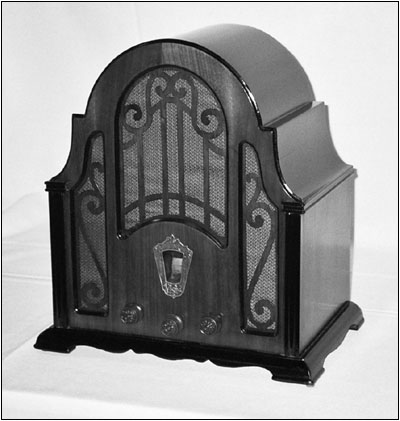
The Ozarka Model 93.
Although the following information is from the Ozarka Model 93B brochure, John notes that the description applies to his Model 93 as well.
The chassis is 14" long, 87/8" deep, and 73/4" high overall. The weight is 22 lbs. The seven tube types are as follows: 227 oscillator, 235 signal amplifier, 235 modulator, 235 intermediate frequency amplifier, 227 second detector, 247 power amplifier, and 280 rectifier. The new type 235 variable µ (mu) tubes used in the first three stages insure against disagreeable cross modulation and reduce hiss to a minimum.
The new 247 pentode in the output stage gives a power output of three watts or equal to two Type 245 tubes. The amplification obtained is 30 times that of a Type 245.
Complete shielding is employed, allowing maximum selectivity and sensitivity. In addition, radiation from the local oscillator is kept at a low level. The instrument will not interfere with other receivers located in the neighborhood.
Electrolytic condensers are used in the filter system. Due to their high capacity, hum is reduced to a low level, and their self-healing characteristic makes breakdown impossible.
The large transformer is so designed that the temperature rise is low, thereby insuring long life and preventing burnouts. Resistance coupling is used between the detector and pentode. Due to the fact that there is absolutely nothing in this circuit to cause distortion, the tone quality is exceptional. The dynamic speaker of high quality is carefully matched to the receiver, insuring the best possible performance.
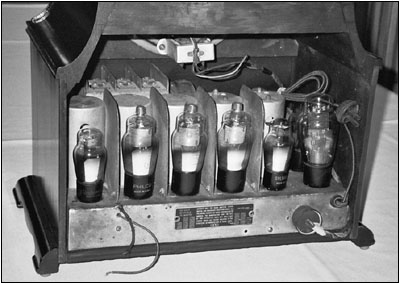
A rear view of the Model 93 showing the unusual 6-tube line-up on the rear edge of the chassis.
The RF system is so designed that uniform gain and selectivity are obtained over the entire frequency band. A power line filter condenser prevents RF disturbances in the power line from affecting the instrument and eliminates the necessity for a ground connection in most cases.
The sturdy 3-gang condenser for tuning is accurately balanced and adjusted to match the RF coils. Each section is fully shielded from the adjacent section of the gang.
The illuminated drum dial, calibrated in kilocycles for easy tuning, gives perfect visibility. The tuning control is simple and positive in action. Constant tension removes all chance for drag or backlash. The absence of friction throughout results in smooth easy tuning.
The strong heavy steel base is die-formed and spot-welded at corners. It is rigid enough to support a chassis twice the size and weight. It is copper-plated and has a tough, elastic coat of clear Japan, resulting in a most attractive finish.
Tube and coil shields are of heavy gauge material. The tube sockets are of the latest improved type with powerful spring contacts mounted on laminated Bakelite grips creating tubes with perfect contact.
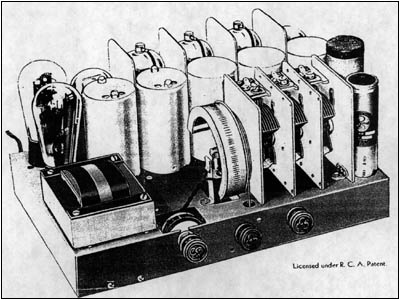
A front view of the Model 93B chassis showing the component layout. (From the Model 93B brochure, contributed by Peter Burton).
(John DeLoria, 101 Doverbrook Rd., Chicopee, MA 01022. Peter Burton, Box 91, Belchertown, MA 01007)
In 1988, John DeLoria asked a collector uncle to repair a Radiola 18 for him -- an event he describes as "the beginning of the end." He stopped counting the number of sets in his collection at 2,600. His focus now is on speakers and rare cathedrals, and he credits his wife with supporting him in the hobby.
Peter Burton started collecting in 1975 after falling love with a Zenith 16A63 console at a church rummage sale. For many years, he researched the Ozarka Co., and he has a large collection of original Ozarka letters and papers.
The RCA Radiola 16 -- Last of the Pre-Electric Battery Sets
by Richard Arnold
Web Edition
As AC-operated radios reached the marketplace, battery sets were still being advertised. Richard Arnold tells us how an old ad sparked his interest. (Editor)
I am looking at a newspaper, the Oklahoma City Daily Oklahoman. It is dated September 1927 and contains a radio ad from a department store named Pettee's. In this ad, the company is advertising both the new electric RCA Radiola 17 for 1927 and the new RCA Radiola 16 battery set. In describing the Radiola 17, the ad says, "Operates directly from the electric light circuit without batteries or battery eliminators. It is tuned with one knob. Entire set an A.C. unit in a mahogany finished cabinet." Less the accessories, the price was $130.
The RCA Radiola 16
However, the radio in this article, the Radiola 16, is advertised as follows: "Radiola 16, furnishes the widest musical ranges ever achieved with one dial control, a 6-tube model, less accessories, $69.50." This was about half the price of the all-new electric, Radiola 17. The Radiola 16 sold for $79.75 with six Radiotron tubes. This particular dealer had decided to sell the Radiola and Atwater Kent lines. It gave them the ability to reach the average person, as well as the more affluent customers.
The Radiola 16, shown in Figures 1 and 2, looks a lot like the Radiola 17 or 18, especially inside, but it has a somewhat shorter cabinet, measuring approximately 16 x 7 3/4 x 7 inches. It is advertised as sensitive, selective and compact. The cabinet is also mahogany finished. It is the last conventional battery set offered by RCA. For those of you who don't know, these early RCA radios were, of course, made by General Electric and Westinghouse. They were offered for sale by RCA, as the three companies were all working together at the time.
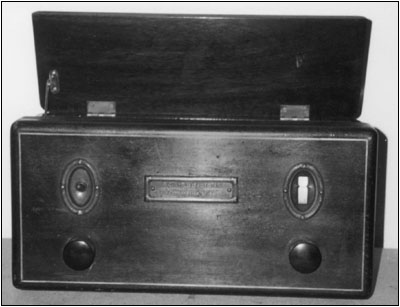
Figure 1. A front view of the RCA Radiola 16. The symmetrical arrangement of controls includes a volume control, lower left, a tuning control, lower right, and the on/off switch, upper left. The tuning dial is located above the tuning knob.
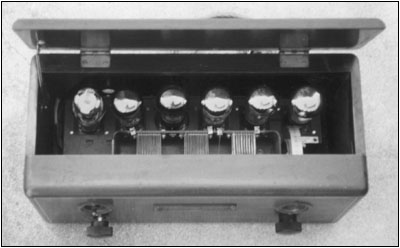
Figure 2. An inside peek shows the six tubes and the tuning capacitor.
The Radiola 16 is a 6-tube, TRF type receiver with three stages of radio frequency amplification, a detector and two stages of audio frequency amplification. The Radiola 16 is of the "Uni-Selector" type, having but a single tuning control. It has excellent sensitivity and selectivity on a broadcast band range of approximately 550 to 1400 kilocycles or 545 to 214 meters. The six tubes used are: five UX-201-As and one UX-112 that is used in the last audio stage.
The Radiola 16 has an on/off switch, a volume control, and a single knob station selector that operates an unlighted drum type selector dial. This is the same as used in the Radiola 17 and Radiola 18 Models. The Model 16 does not use a lamp hood as do the models 17 and 18. The company's recommended loudspeaker is the RCA Radiola 100-A. RCA said that this loudspeaker was a new accomplishment in acoustics. It corresponded in its attainments to the receiving qualities of the Radiola 16. I will have to admit that the 100-A speaker is a very good one. I have two of them that I use most of the time when I play my battery sets, and they do have great sound.
In my research into the radio, I found that there were only 85,000 of the Radiola 16s made. These radios are not all that common nowadays, it seems, but they do show up once in a while. It looks like a neat radio and since it is the last of the early RCA battery sets, it is a piece of history that we can still have at a reasonable price. I know it is a plain looking set, but still in all, it would look nice on the shelf with the rest of your early battery sets.
References:
The Daily Oklahoman, September 1927.
RCA Radiola 16 Instruction Manual 1B-16.
(Richard Arnold, P.O. Box 275, Lone Grove, Oklahoma 73443. E-mail: arnold@brightok.net)
Richard Arnold, a frequent contributor to A.R.C., has been collecting radios since 1985. His interest is primarily in cathedrals and 1920s battery sets, and his collection ranges from crystal sets to a 1928 American Bosch in a Pooley cabinet. His prize is the 1932 Jackson Bell Peter Pan featured in the June 1991 A.R.C.
�
| [Free Sample] [Books, etc., For Sale] [Subscribe to A.R.C./Renew] [Classified Ads] [Auction Prices] [Event Calendar] [Links] [Home] [Issue Archives] [Book Reviews] [Subscription Information] [A.R.C. FAQ] URL = http://www.antiqueradio.com/Mar04_Deloria_Ozarka.html Copyright © 1996-2004 by John V. Terrey - For personal use only. Last revised: February 28, 2004. For Customer Assistance please contact ARC@antiqueradio.com or call (866) 371-0512 Pages designed/maintained by Wayward Fluffy Publications
Antique Radio Classified |